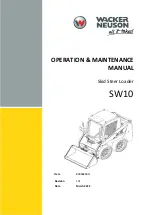
•
Use care when loading or unloading the machine into a
trailer or truck.
•
Use care when approaching blind corners, shrubs, trees,
or other objects that may obscure vision.
•
Read all the attachment manuals.
•
Ensure that the area is clear of people before operating
the machine. Stop the machine if anyone enters the area.
•
Never leave a running machine unattended. Always lower
the loader arms, shut off the engine, engage the parking
brake, and remove the key before leaving.
•
Do not exceed the rated operating capacity, as the
machine may become unstable, which may result in loss
of control.
•
Do not carry a load with the arms raised. Always carry
loads close to the ground.
•
Do not overload the attachment and always keep the load
level when raising the loader arms. Logs, boards, and
other items could roll down the loader arms, injuring you.
•
Never jerk the controls; use a steady motion.
•
Watch for traffic when operating near or crossing
roadways.
•
Do not touch parts that may be hot from operation.
Allow them to cool before attempting to maintain, adjust,
or service the machine.
•
Check for overhead clearances (i.e., branches, doorways,
and electrical wires) before driving under any objects and
do not contact them.
•
Operate the machine in areas where there are no obstacles
in close proximity to you. Failure to maintain adequate
distance from trees, walls, and other barriers may result
in injury as the machine backs up during operation if
you are not attentive to the surroundings. Operate the
machine only in areas where there is sufficient clearance
for you to safely maneuver.
•
Note the location of unmarked objects and structures,
such as underground storage tanks, wells, and septic
systems.
•
Locate the pinch point areas marked on the machine and
attachments and keep your hands and feet away from
these areas.
•
Before operating the machine with an attachment, ensure
that the attachment is properly installed and that it is a
genuine Toro attachment.
•
Do not place your feet under the platform, if equipped
on your machine.
•
Lightning can cause severe injury or death. If lightning
is seen or thunder is heard in the area, do not operate
the machine; seek shelter.
Slope Operation
Slopes are a major factor related to loss-of-control and
tip-over accidents, which can result in severe injury or death.
All slopes require extra caution.
•
Do not operate the machine on hillsides or slopes
exceeding the angles recommended on
(page 7)
, and those in the attachment
Operator's Manual
.
See also the
Slope Indicator (page 8)
.
•
Operate the machine up and down slopes with the
heavy end of the machine uphill.
Weight distribution
changes. An empty bucket makes the rear of the machine
the heavy end, and a full bucket makes the front of the
machine the heavy end. Most other attachments make the
front of machine the heavy end.
•
Raising the loader arms on a slope affects the stability of
the machine. Whenever possible, keep the loader arms in
the lowered position when on slopes.
•
Do not remove or add attachments on a slope.
•
Remove obstacles such as rocks, tree limbs, etc. from the
work area. Watch for holes, ruts, or bumps, as uneven
terrain could overturn the machine. Tall grass can hide
obstacles.
•
Use only Toro-approved attachments. Attachments can
change the stability and the operating characteristics of
the machine. You may void the warranty if you use the
machine with unapproved attachments.
•
Keep all movements on slopes slow and gradual. Do not
make sudden changes in speed or direction.
•
Avoid starting or stopping on a slope. If the machine
loses traction, proceed slowly, straight down the slope.
•
Avoid turning on slopes. If you must turn, turn slowly
and keep the heavy end of the machine uphill.
•
Do not operate near drop-offs, ditches, or embankments.
The machine could suddenly turn over if a track goes
over the edge of a cliff or ditch, or if an edge caves in.
•
Use caution when operating on wet grass. Reduced
traction could cause sliding.
•
Do not park the machine on a hillside or slope without
lowering the attachment to the ground, engaging the
parking brake (if equipped), and chocking the tracks.
•
On machines with an operator platform, do not try to
stabilize the machine by putting your foot on the ground.
5
Summary of Contents for 22327
Page 54: ...Schematics g205307 Electrical Schematic Rev B 54...
Page 55: ...g206362 Hydraulic Schematic Rev B 55...
Page 56: ...Notes...
Page 57: ...Notes...
Page 58: ...Notes...





















